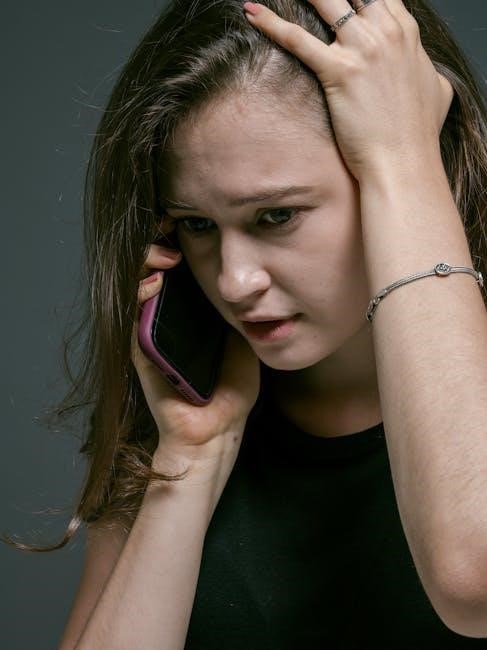The Liebowitz Social Anxiety Scale is a 24-item questionnaire designed to assess fear and avoidance in social situations, aiding in the diagnosis and measurement of social anxiety disorder.
Overview of the LSAS and Its Purpose
The Liebowitz Social Anxiety Scale (LSAS) is a 24-item self-report questionnaire designed to evaluate the severity of social anxiety disorder (SAD) symptoms. It assesses both fear/anxiety and avoidance across various social and performance situations. The scale helps clinicians and researchers understand the extent to which social anxiety impacts an individual’s daily life. By measuring fear and avoidance levels, the LSAS provides valuable insights into the functional impairment caused by social phobia. It is widely used in both clinical and research settings to aid in diagnosis, monitor treatment progress, and develop targeted interventions for individuals with social anxiety disorder.
History and Development of the Scale
The Liebowitz Social Anxiety Scale (LSAS) was developed in the 1980s by Michael R. Liebowitz to assess the severity of social phobia symptoms. Initially known as the Liebowitz Social Phobia Scale (LSPS), it was designed to evaluate both fear and avoidance in social situations. The scale was later refined and validated for broader use in clinical and research settings. Its development marked a significant advancement in the field of social anxiety disorder (SAD), providing a standardized tool to measure symptom severity and treatment outcomes. The LSAS has since become a widely recognized and reliable instrument for assessing social anxiety globally.

Structure and Content of the LSAS
The LSAS consists of 24 items assessing fear and avoidance in social situations. Each item is rated on a 0-3 scale, measuring anxiety and avoidance levels.
24-Item Assessment: Fear and Avoidance in Social Situations
The LSAS includes 24 items, each evaluating fear and avoidance in specific social contexts. Participants rate their anxiety and avoidance on a 0-3 scale. Situations range from interactions like using a telephone in public to participating in small groups, covering both social and performance-related scenarios. Each item assesses two dimensions: fear (e.g., feeling anxious in a situation) and avoidance (e.g., avoiding the situation altogether). This dual focus provides a comprehensive understanding of how social anxiety impacts daily life. The scale is widely used in clinical and research settings to evaluate the severity of social anxiety symptoms.
Scoring System: Rating Fear and Avoidance Levels
The LSAS employs a 0-3 scale for rating fear and avoidance levels, with 0 indicating no fear or avoidance and 3 representing severe anxiety or consistent avoidance. Each of the 24 items is scored individually, allowing for a detailed assessment of social anxiety symptoms. The total score ranges from 0 to 144, providing a comprehensive measure of symptom severity. This scoring system is not only reliable but also widely used in clinical settings to monitor progress and in research to evaluate treatment efficacy.

Use and Validation of the LSAS
The LSAS is widely used in clinical and research settings to assess social anxiety severity, with strong psychometric properties and cross-cultural validation, ensuring reliable and consistent measurements.
Psychometric Properties and Reliability
The LSAS demonstrates strong psychometric properties, including high internal consistency and test-retest reliability, making it a reliable tool for assessing social anxiety across diverse populations. Validation studies have shown that the scale effectively measures both fear and avoidance dimensions, with consistent results across clinical and non-clinical samples. Its reliability has been established through various cultural adaptations, ensuring its applicability in different cultural contexts. Researchers have consistently reported high correlation between the fear and avoidance subscales, further validating its use as a comprehensive assessment tool for social anxiety disorder.
Clinical Applications and Research Use
The Liebowitz Social Anxiety Scale is widely used in clinical settings to assess and monitor the severity of social anxiety disorder. It serves as a valuable tool for evaluating treatment outcomes and has been employed in numerous clinical trials to measure the efficacy of interventions. Researchers often utilize the LSAS as a primary endpoint in studies due to its robust psychometric properties. Additionally, the scale has been adapted for use in diverse cultural contexts, enhancing its applicability in cross-cultural research. Its availability as a self-report version further expands its utility in both clinical practice and research, making it a cornerstone for understanding and addressing social anxiety disorder.

Understanding Social Anxiety Through the LSAS
The Liebowitz Social Anxiety Scale (LSAS) provides a comprehensive framework for diagnosing and understanding social anxiety disorder by evaluating fear and avoidance in various social situations.
Defining Social Anxiety Disorder (SAD)
Social Anxiety Disorder (SAD), also known as social phobia, is a mental health condition characterized by an intense, persistent fear of social interactions. It involves significant distress or impairment in social, occupational, or daily life situations due to fear of embarrassment, judgment, or rejection. The Liebowitz Social Anxiety Scale (LSAS) is a key tool for evaluating the severity of SAD by assessing fear and avoidance across 24 social scenarios.
Symptoms of SAD often include physical reactions like palpitations or sweating, as well as avoidance behaviors to escape anxiety-provoking situations. The disorder is more than simple shyness; it represents a profound and disabling fear of social interactions that interferes with daily functioning and relationships.
Assessing the Impact of Social Phobia
The Liebowitz Social Anxiety Scale (LSAS) is instrumental in evaluating the impact of social phobia on an individual’s life. It assesses both fear and avoidance across 24 social situations, providing insights into how social anxiety interferes with daily interactions and relationships. By measuring the severity of anxiety and avoidance, the LSAS helps identify how deeply social phobia affects a person’s ability to engage in social and professional activities. This assessment is crucial for understanding the broader implications of social phobia, such as impaired occupational functioning, strained personal relationships, and reduced quality of life. The scale’s findings guide treatment plans and monitor progress over time.
Cultural and Demographic Considerations
The LSAS has been adapted for various cultures and demographics, ensuring its validity across diverse populations. Studies highlight its use in different languages and regions, such as Indonesia and Latin America.
Cultural Adaptations of the LSAS
The LSAS has undergone cultural adaptations to ensure its validity across diverse populations. Researchers have translated and validated the scale in multiple languages, including Indonesian and Spanish, to accommodate non-English speaking individuals. These adaptations involve collaboration with cultural experts to maintain the scale’s accuracy and relevance. For instance, the LSAS-SR-Indonesia was validated for use in Indonesia, demonstrating its reliability in assessing social anxiety symptoms. Additionally, studies have been conducted in Latin America, Spain, and Portugal, further expanding its cross-cultural applicability. Such efforts ensure the scale remains effective in evaluating social anxiety across different cultural contexts and demographics.
Demographic Studies and Variations
Demographic studies reveal variations in LSAS scores across age, gender, and cultural groups. Research indicates higher anxiety levels in women compared to men, with younger adults often reporting greater social anxiety. Studies conducted in Japan and Latin America demonstrate regional differences in how social anxiety manifests. For example, in Japan, fear of negative evaluation in public settings is particularly pronounced. Additionally, the scale has been validated for use in various age groups, including adolescents and older adults, ensuring its applicability across the lifespan. These variations highlight the importance of considering demographic factors when interpreting LSAS results, allowing for more personalized assessments and interventions.
Accessing and Utilizing the LSAS PDF
The LSAS PDF is a widely available tool for assessing social anxiety, offering a structured format with clear instructions for completion and scoring.
Downloading the LSAS as a PDF
The Liebowitz Social Anxiety Scale is widely available online as a downloadable PDF, offering a convenient tool for clinicians and researchers to assess social anxiety.
Individuals can access the LSAS PDF through academic websites, research portals, or mental health organizations, ensuring easy distribution and use for diagnostic purposes.
The PDF format includes the full 24-item questionnaire, with clear instructions for rating fear and avoidance levels, making it a straightforward resource for both professionals and participants.
Additionally, the LSAS PDF often includes scoring guidelines and references, providing a comprehensive guide for understanding and interpreting results effectively.
Its availability in multiple languages further enhances its accessibility, allowing global use in diverse clinical and research settings.
Instructions for Completing and Scoring the Scale
The Liebowitz Social Anxiety Scale is completed by rating 24 social situations on a 0-3 scale for both fear/anxiety and avoidance. For each item, individuals assess their fear (0 = none, 1 = mild, 2 = moderate, 3 = severe) and avoidance (0 = never avoid, 1 = occasionally avoid, 2 = often avoid, 3 = usually avoid); Scores are summed to provide total fear, avoidance, and overall scores, ranging from 0 to 72. Higher scores indicate greater social anxiety. The scale is self-administered and typically takes 10-15 minutes to complete, with scoring guidelines provided in the PDF document.

Practical Implications and Further Reading
The Liebowitz Social Anxiety Scale is widely used in clinical and research settings to assess social anxiety severity. For further reading, the LSAS PDF provides detailed scoring instructions and references for additional resources on social anxiety disorder.
Using the LSAS in Therapy and Research
The Liebowitz Social Anxiety Scale is a versatile tool for both therapeutic and research applications. In therapy, it helps identify specific social situations that trigger anxiety, allowing for targeted interventions. Clinicians use the LSAS to monitor progress and tailor treatment plans. In research, the scale is employed to evaluate the efficacy of interventions and therapies for social anxiety disorder. Its standardized format ensures consistency across studies, making it a reliable measure for comparing outcomes. The LSAS also facilitates cross-cultural research, as it has been adapted for use in diverse populations. Its psychometric properties make it a valuable instrument for assessing both fear and avoidance behaviors in social contexts.
Additional Resources and References
The Liebowitz Social Anxiety Scale is widely available as a downloadable PDF, providing easy access for clinicians and researchers. The scale has been referenced in numerous studies, including works by Heimberg, Fresco, and Schneier, which highlight its validity and reliability. For further reading, the Journal of Clinical Psychology and Behaviour Research and Therapy feature articles on its application and psychometric properties. Translations of the LSAS are available for cross-cultural research, and adaptations like the LSAS-SR (self-report version) offer additional tools for assessment. Researchers and practitioners can access these resources through academic databases or mental health organization websites, ensuring comprehensive understanding and effective use of the scale in both clinical and research settings.